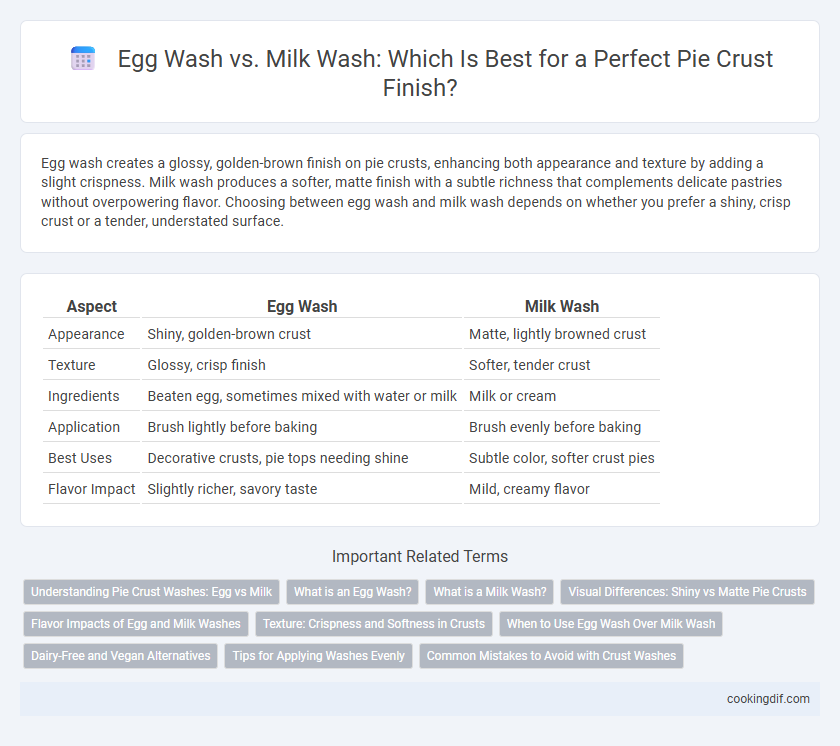Egg wash creates a glossy, golden-brown finish on pie crusts, enhancing both appearance and texture by adding a slight crispness. Milk wash produces a softer, matte finish with a subtle richness that complements delicate pastries without overpowering flavor. Choosing between egg wash and milk wash depends on whether you prefer a shiny, crisp crust or a tender, understated surface.
Table of Comparison
| Aspect | Egg Wash | Milk Wash |
|---|---|---|
| Appearance | Shiny, golden-brown crust | Matte, lightly browned crust |
| Texture | Glossy, crisp finish | Softer, tender crust |
| Ingredients | Beaten egg, sometimes mixed with water or milk | Milk or cream |
| Application | Brush lightly before baking | Brush evenly before baking |
| Best Uses | Decorative crusts, pie tops needing shine | Subtle color, softer crust pies |
| Flavor Impact | Slightly richer, savory taste | Mild, creamy flavor |
Understanding Pie Crust Washes: Egg vs Milk
Egg wash creates a glossy, golden-brown finish on pie crusts due to its protein and fat content, enhancing both appearance and texture. Milk wash provides a softer, matte finish with a slight browning effect, contributing to a tender crust surface. Choosing between egg and milk wash depends on the desired crust aesthetic and flavor profile for the pie.
What is an Egg Wash?
An egg wash is a mixture made from beaten eggs, often combined with water or milk, applied to pie crusts before baking to create a glossy, golden-brown finish. The proteins and fats in the egg wash promote browning and a crisp texture, enhancing the pie's visual appeal and flavor. Compared to milk wash, egg wash provides a richer color and stronger crust sheen.
What is a Milk Wash?
Milk wash is a common pastry technique involving brushing milk onto pie crusts before baking to achieve a golden, matte finish with subtle browning. This method enhances the crust's texture and color without producing the glossy sheen characteristic of an egg wash. Using milk wash optimizes the crust's moisture retention, resulting in a tender, softly crisp outer layer.
Visual Differences: Shiny vs Matte Pie Crusts
Egg wash creates a glossy, shiny pie crust by adding a rich golden color and a smooth finish when baked, enhancing visual appeal with a reflective surface. Milk wash results in a matte crust that appears softer and less vibrant in color, providing a more natural and rustic look. Choosing between egg wash and milk wash depends on the desired aesthetic effect of the pie crust's texture and shine.
Flavor Impacts of Egg and Milk Washes
Egg wash imparts a rich, golden-brown color and a slightly savory flavor to pie crusts due to its protein and fat content, enhancing both texture and visual appeal. Milk wash, on the other hand, creates a softer, less glossy finish with a subtle sweetness that complements fruit and custard pies without overpowering their flavors. Choosing between egg and milk wash depends on the desired balance of crust flavor and appearance, as egg wash intensifies richness while milk wash maintains a tender, delicate taste.
Texture: Crispness and Softness in Crusts
Applying an egg wash on pie crusts creates a glossy, golden finish with a crisp texture due to the proteins that coagulate during baking. In contrast, a milk wash results in a softer, more tender crust as the lactose and fats promote browning without significantly toughening the surface. Bakers often choose egg wash for flaky, crunchy pies while milk wash is preferred for a delicate, lightly browned crust.
When to Use Egg Wash Over Milk Wash
Egg wash is preferred over milk wash when aiming for a glossy, golden-brown crust with a slightly thicker and more durable finish. It is especially effective for savory pies where a rich color and enhanced texture are desired, such as meat or vegetable pies. Egg wash also aids in better adherence of toppings like seeds or sugar, providing a visually appealing and sturdy crust.
Dairy-Free and Vegan Alternatives
Egg wash creates a glossy, golden crust through proteins and fat, while milk wash adds a softer, slightly sweet finish due to lactose and milk fats. For dairy-free and vegan alternatives, plant-based milk like almond, soy, or oat milk can mimic milk wash, and aquafaba or melted coconut oil replicate egg wash's shine and browning properties. Choosing the right alternative depends on desired crust texture and dietary needs, ensuring a beautiful, vegan-friendly pie crust.
Tips for Applying Washes Evenly
To achieve a perfectly golden and glossy pie crust, apply egg wash with a soft pastry brush, ensuring a thin, even layer that prevents pooling and sogginess. For milk wash, use a light, sweeping motion to create a subtle sheen and avoid over-saturating the dough, which can lead to a dull finish. Chilling the pie crust before brushing helps the wash adhere better, resulting in a uniform, attractive crust texture.
Common Mistakes to Avoid with Crust Washes
Applying an egg wash too thickly can cause the pie crust to appear overly shiny or unevenly browned, while using milk wash improperly may result in a dull, less appealing finish. A common mistake is failing to brush the wash consistently across the crust, leading to patchy coloring and texture differences after baking. Avoid reapplying washes multiple times during baking, as this can cause sogginess or burning on the crust's surface.
Egg wash vs milk wash for crust finishing Infographic

 cookingdif.com
cookingdif.com